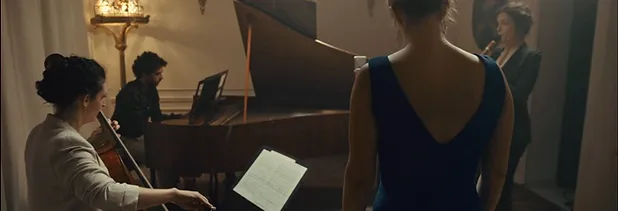
Grand piano JB Streicher 1847

Piano à queue
Johann Baptist Streicher n°4032, vienne 1847
A romantic and classical piano
By Sally Sargent
This piano is an absolute wonder. It was built by Johann Baptist Streicher in 1847.
He is one of three generations of piano makers in Vienna from 1802 to 1896. Johann Baptist is known for his numerous innovations in the production of sound through technical processes and the use of materials.
The beauty of this piano is that it has both classical and romantic characteristics. On the one hand, this instrument with traditional Viennese mechanics with hides covering the hammers and a very shallow key depth (4 to 5 mm) looks back to the past by choosing this beautifully clear and objective singing sound with many color nuances.
On the other hand, this piano looks to the future with a very rich bass sound and a desire for fusion and blending of sound. Thus, the pianist will feel in adequacy with the scores not only of Beethoven but also of Schumann, Chopin and Liszt. It is a field of experimentation for the pianist who must find through his or her interpretation the right language at the time.
Johann Baptist Streicher's mother - Nannette Streicher (née Stein), the founder of the firm and a friend of Beethoven's - wrote that for a Viennese audience, the most valued quality was the ability to sing delicate pianissimi.
The sound characteristics of Streicher pianos were much admired by many pianists, including Clara Schumann and Liszt. It was Johann Baptist Streicher's son - Emil - who supplied Johannes Brahms with a parallel string piano in 1868 with a Viennese action, which Brahms played in his music room until the end of his life.
Sally Sargent, renowned pianist and teacher, assistant to Paul Badura Skoda at the University of Vienna.
She wrote the article on Touch in The New Grove Dictionary of Music and Musicians. Member of La Nouvelle Athènes
La Nouvelle Athènes Collection
Grand piano Johann Baptist Streicher, n°4032, Vienna 1847
Mahogany body, 7 octaves A - A, tri-string, Viennese mechanism, leather hammers. 2 pedals : una corda, forte
242 cm long*140cm wide* 46 cm high 300kg
acquired from the Edwin Beunk Collection, conservator
accessible at the Salon Streicher, near Buttes Chaumont, Paris
DONATION FROM THE FOUNDATION L'OR DU RHIN



